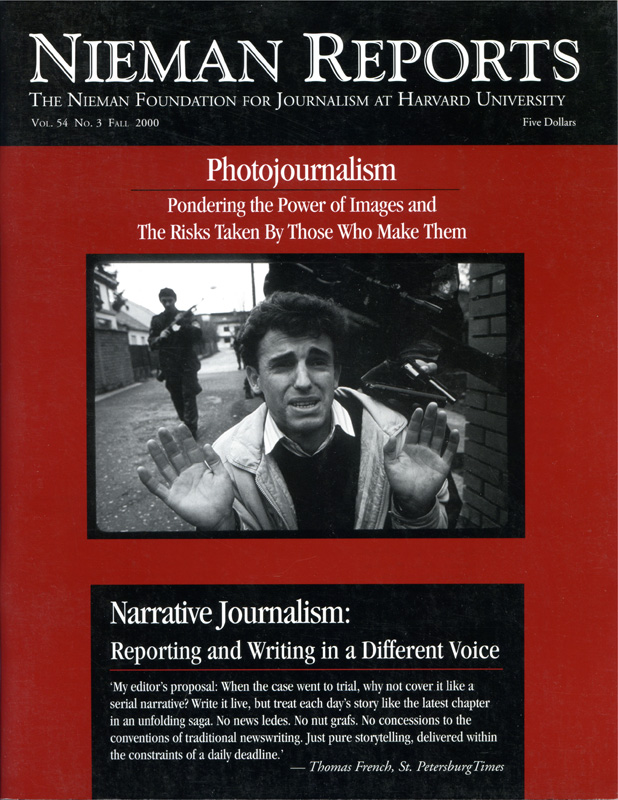In May of this year, The Crimes of War Project, chaired by Newsday correspondent Roy Gutman, and The Freedom Forum co-sponsored an Arlington, Virginia conference called “The World of Conflict.” Panelists and audience participants discussed topics related to the coverage of war by writers and photographers. One panel consisting of three war photographers—Ron Haviv, Gary Knight, and Steve Lehman—described experiences from the frontlines of battles and talked about their work as journalists. Susan Moeller, a contributor to Nieman Reports and author of “Compassion Fatigue: How the Media Sell Disease, Famine, War and Death,” moderated this panel. Edited excerpts from it follow.
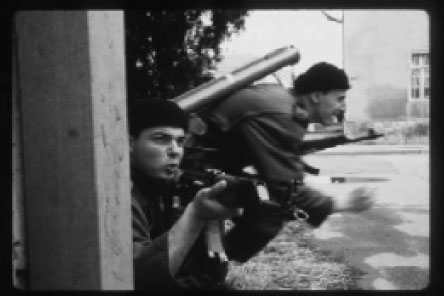
Arkan’s Tigers fight during the first battle for Bosnia in the town of Bijelina, March 1992. Photo by Ron Haviv/SABA.
Susan Moeller: “Images, of course, are how most of us experience conflict. And for those of us who haven’t been on the frontlines or haven’t been on certain frontlines, the way we learn about the world, the way we learn about war crimes, particularly, is often through the camera.
“Yet the images the photographers take, even by those within the media, are often taken too much for granted. They are used as illustrations. And I use that word in a pejorative sense. They are used as attention grabbers. But they often are not considered as thoughtfully as the text that accompanies them.
“There is often little integration between the text and the images. And I would suggest that this problem has only worsened and is particularly a problem on Web sites, on traditional news institutions that are going online….”
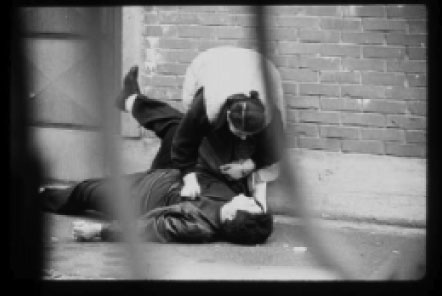
The wife of a Bosnian Muslim tries to help her husband as he lays dying after being shot by Arkan’s Tigers. The woman was later shot as well. Both died. Photo by Ron Haviv/SABA.
Ron Haviv [Newsweek contract photographer]: “Arkan was one of the more famous warlords of the wars in Yugoslavia. [H]e was responsible for killing thousands and thousands of people. And I was fortunate or unfortunate enough to travel with him and his unit called the Tigers into the first battle of Bosnia. We moved through town basically fighting from street to street, and we then arrived at the center of town at one of the mosques. And they immediately broke into the mosque and went upstairs, took down the Islamic flag, hung up a Serbian flag, and defaced some different property and things like that inside the mosque.
“There was still a lot of shooting going on outside. I was inside at the time photographing the soldiers inside the mosque. And I heard sort of a higher level of shooting, and I walked outside and I saw the soldiers bringing out people from a house across the street. They first brought out a man and were shouting at him in Serbian. I still don’t know to this day exactly what they were saying. And then they brought out a woman who was his wife and she started to scream. And a couple of shots rang out, and the man went down. The woman screamed some more.
“Meanwhile, while this is all happening, several soldiers are looking at me. Well, I’m standing there with my cameras watching and wondering when they are not looking at me so I can actually take a photograph, and they’re screaming at me in Serbian, ‘Don’t take any photographs. Don’t take any photographs.’ So the tension level obviously was quite high for me. From previous experiences in the other wars in Yugoslavia, I had witnessed two other executions at which I had a gun pointed to my head, and I was not allowed to photograph it.
“I had made a promise to myself that the next time I was in this situation I would do my best not to leave without a photograph, because otherwise there’s really no reason that we’re there. I mean, we’re there to document that, and I was going to do my best to get this on film. So there’s a crash truck parked in the middle of the street. And during the commotion I sort of walked very, very slowly, like inch by inch, so it kind of didn’t look like I was moving too fast, and hid by part of the truck where the soldiers couldn’t see me because my view was blocked. But I was able to see the man and the woman, and I was able to photograph the two of them together as he lay dying.
“Within several minutes, some more shots rang out and they shot the woman. And they brought out another woman and then, of course, she was killed. And all three are lying dead on the street. Now, I know I have a photograph of the people, but I don’t have a photograph of the soldiers with the people, which is what I need to prove that these Serbian soldiers were the ones that killed them. I mean, aside from my word, I wanted to have it actually on film.
“The unit decided to leave, and most of them left. There were three guys behind. And I went and I stood in the middle of the street. This time I was completely exposed. And I wanted just to get a photograph of the soldiers walking past the bodies. So as they came past the bodies, I raised my camera. And as they came past, one of the soldiers, cigarette in his hand, sunglasses on his head, brought back his foot and kicked the bodies. And I was able to take several photographs of that. And luckily for me, they didn’t see me, because two were looking to their left and one had his back to me as he was kicking the bodies.
“I took the pictures, I put my camera down, and I said to the soldiers, “Let’s go, great job, let’s go.” And we ran off like trying to hope that they wouldn’t have any idea what had happened.
“They had taken another prisoner at the same time and this guy was still alive, and as we were running up the street, I wanted to try and get a photograph of this prisoner. So I ran ahead to the soldier that was holding him and I said, ‘I want to take a photograph.’ So he grabbed the prisoner, put him down on the ground, and the photograph is of the prisoner with his hands up in the air, with the gun to his head and several soldiers in the background.
“For me it was very difficult because his hands are in the air and he’s begging for his life. But he’s begging me to try to save him, and there was nothing at that time that I could do. And this is a situation that I’ve been in, other people have been in, and these are very difficult situations for photographers and journalists and cameramen. And when do you decide to intervene if you can, and what influence can you have over the situation?
“They brought that prisoner back to the headquarters or house that they had taken over. They were interrogating him. I was standing outside waiting to see what happened and I heard a great crash. And I looked up and out of a third-story window, the prisoner came flying out of the window and landed at my feet. Then a couple of soldiers came out and they started kicking him and beating him, and I started taking some more photographs of that. And then they dragged him back into the house. A few minutes later, Arkan arrived, he came back from directing the battle from a different part of the city. They told Arkan that I’d taken these photographs, and Arkan knew immediately that this was a problem and asked for my film.
“I then proceeded to get into an argument with Arkan about how valuable the film was to the Serbian cause and things like that, to which he replied that he would process the film and edit the film and whatever pictures he thought were okay he’d give back to me. I replied, ‘Well, the labs aren’t very good in Belgrade. The quality isn’t good. Let me process it myself and then I’ll give you the pictures and you can use them.’ While this was being done, I was hiding several of the rolls of film that I’d already taken before and was able to save most of the film. Unfortunately, I had to just give one roll to Arkan, and that roll was of the prisoner falling out of the window.
“The next week, the photographs were published in Time magazine and several others. What’s interesting about these photographs is that this was a week before the war officially began in Sarajevo. And these pictures were published by American magazines and seen by American politicians, as well as German politicians and French politicians. I was always quite sad that there was no reaction by the politicians to these photographs. They had seen that this ethnic cleansing had started and they still had an opportunity to stop actually what was going to happen three weeks later in Sarajevo.
“As for myself, there was a big backlash. Arkan got into a lot of trouble for letting me take these photographs. Milosevic was quite upset. There were some internal documents that were actually published a few years later from Milosevic to Arkan about this attack and their strategies and stuff like that. I was put onto a death list by the Serbs and I had a great deal of difficulty in the following years covering the story, always wondering who was looking for me, trying to avoid Arkan in all possible cases. I wound up in Kosovo missing him twice in the lobby of a hotel.
“This is an indicative story, maybe a little bit of an extreme one, but I and all of my colleagues have gone through these types of situations in many different scenarios. We’ve all been threatened to different degrees. Several people have been captured, myself included on a different story, mock executions, things like that. Basically we’re alone. Left up to our own wits. If we lose our equipment or we get wounded, it’s often up to the freelance photographer to protect himself or herself….”
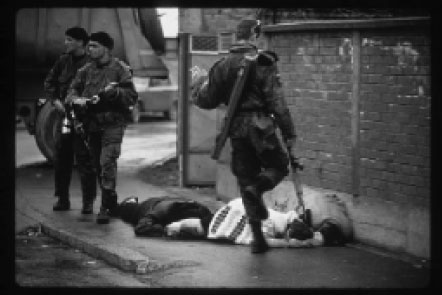
Arkan’s Tigers with the two women and a man that they had just shot during the first battle for Bosnia in March 1992. All three were killed. Photo by Ron Haviv/SABA.
Moeller: “I want to ask the three photographers to speak a little bit about some broader issues, particularly to the role that Ron mentioned of the photographer as an observer and a witness. [We know] there’s been a general retreat from international coverage. And there also has been, of course, a decade-plus of media mergers, particularly in photography. This has hit hard; right now, we have effectively five major corporations that control photography: AFB, AP, Reuters, Getty and Corbis….”
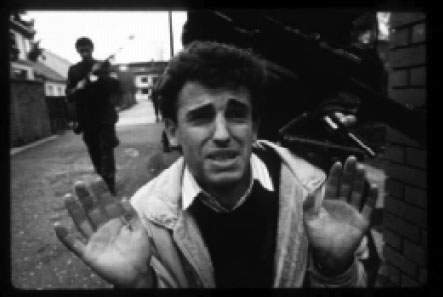
A Muslim man begs for his life as he is taken prisoner by Arkan’s Tigers during the first battle for Bosnia in March 1992. He was later thrown from a third story window during interrogation. Photo by Ron Haviv/SABA.
Gary Knight [Newsweek contract photographer]: “There are fewer young photojournalists coming through. We’re all 34, 35, 36, and considered, you know, the young kids on the block.
“And there are very, very few people who are in their 20’s coming through in this industry, and I think that’s very, very scary because I, for one, will not be doing this in another 30 years, I can assure you.
“[A]s editors you really have to address these issues. Where are you getting your pictures from, and are you really getting a fair reflection of what’s going on? And I would suggest that you have been, but you might not be in the future.”
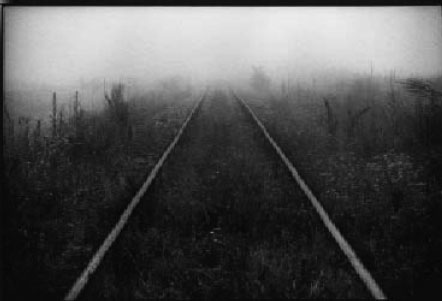
Image of war in Kosovo. Photo by Gary Knight©.
Steve Lehman [photographer and founder of Firsthand Media]: “Specifically, you look at news on the Internet and more and more it’s coming from the same sources which are very, very narrow sources. And so when I look around at visual imagery, it’s all coming from Reuters and AP.
“So essentially you have, on a particular story, one or two individuals covering that story for the entire world. That makes me nervous. The more eyes you have out there, the more different perspectives you have. And the more chances of finding and uncovering important stories. On one hand we have this enormous consolidation going on in terms of visual content industry, but also we as individuals are being empowered, too, where for the first time we can access an audience directly through the Internet. We don’t necessarily have to go out and build a television station. We don’t have to print a magazine each week. And the barrier to entry as far as the news business is concerned is a lot lower. And hopefully it will encourage a new type of journalism…. I’m trying to be optimistic. I’m hoping that this will create new avenues for photojournalists and videographers or multimedia journalists.
“As photojournalists, we’ve pretty much been relegated to the role of illustrators. I think the new technologies will help empower us. For so long we’ve had a print-dominated media. I think in the next few years that it’s going to change in a very dramatic way. What I’m trying to do is embrace those changes and bring photo, text and video journalists together to forge a new type of programming, a new type of communication. And so I want to be optimistic about it, but at the same time it’s a tough battle that we have, and it’s something that we all should recognize because nobody wants to spend money on international news.”

Image of war in Kosovo. Photo by Gary Knight©.
Haviv: “Speaking from my personal experience and from stories that have been told to me by colleagues, text editors seem to look at photography quite often, unless it’s something incredibly dramatic, as illustrations. And I think that most photographers feel that we’re not often given the respect given to the traditional journalists. The concept of the photojournalist does not seem to have gone through all the different levels that exist at newspapers, magazines and wire services.”
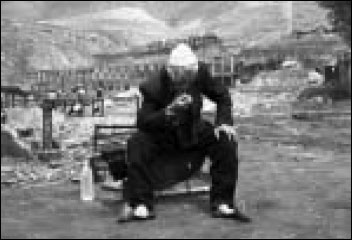
Photo by Gary Knight©.
Audience members then commented.
Audience comment: “I’m only a consumer of the news you cover. When I think of the power that photography has had in shaping public opinion in this country about wars, I think it’s probably the most important thing that has changed and molded public opinion. The Sarajevo market, for example, or Somalia, or that Time magazine cover of refugees fleeing in Bosnia and a woman is walking and…nursing a baby trying to do the most simply ordinary human task that is possible to imagine in the middle of this. I think these photos moved so many people. And I’m sorry that you guys don’t really think you’re appreciated, because I will tell you at least in this precinct here you are really appreciated.”
Audience comment: “I work for a paper that’s really driven by photographs and I’ve had world stories that I wanted to get on Page 1 that didn’t get there because there wasn’t a good enough photograph. And I’ve had other world stories that got out there because there was a great photograph and there was really something else I wanted to put out. So it’s moving in your direction.”
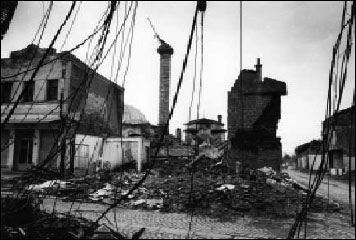
Photo by Gary Knight©.
Audience comment: “I, too, have been a photographer in combat and have also written a book about war photography, and we are talking about illustrations and how they do not have any impact. What we are talking about, at least what I am talking about, is that these photographs are not integrated into the story and the event as a whole, and that they are often a gross simplification of what is happening. The classic example is a famine where you see pictures of the starving babies and with which you certainly get people’s attention. But you lead people to the assumption that you feed the babies and the crisis is over, when most of us in this room, I am sure, are well aware that famines are much more complicated than that. So I think that’s the dilemma that photographers wrestle with.”
Audience comment: “If you look back at the history of photojournalism and magazine reporting during the 1950’s and 60’s there was much more integration between the photographs and text. In those days a photographer and a writer were sent out together to do a story, and they would spend a month or six weeks and go out and work together. They had the time and they had the money to do that. Today, because of financial constraints, people don’t want to pay us to go out for a month. They want to get that in a day or two days or three days because it’s expensive. It’s really an expensive thing to send a photographer off on an assignment or to send a writer on an assignment. If you have to send both of them, then it doubles the cost. I think that is a very significant reason why there is not that integration. But it also has to do with the power structures at magazines or newspapers and how people view the different mediums.


